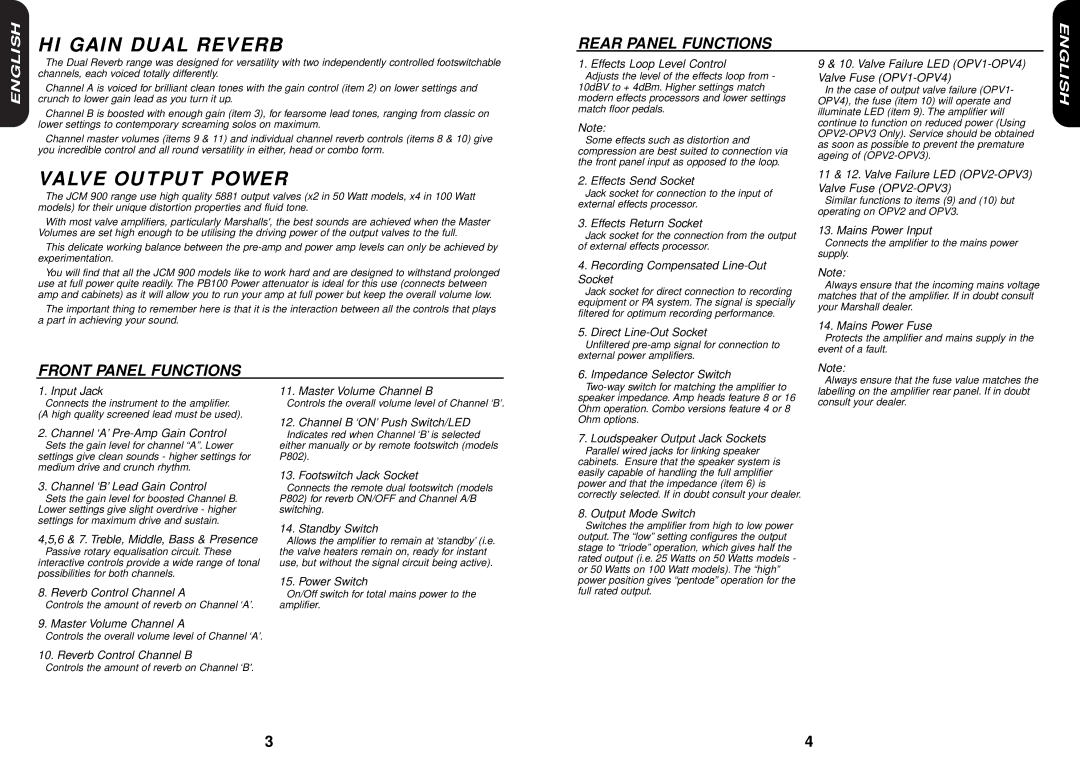
HI GAIN DUAL REVERB |
REAR PANEL FUNCTIONS
ENGLISH | The Dual Reverb range was designed for versatility with two independently controlled footswitchable |
channels, each voiced totally differently. | |
Channel A is voiced for brilliant clean tones with the gain control (item 2) on lower settings and | |
crunch to lower gain lead as you turn it up. | |
| Channel B is boosted with enough gain (item 3), for fearsome lead tones, ranging from classic on |
| lower settings to contemporary screaming solos on maximum. |
| Channel master volumes (items 9 & 11) and individual channel reverb controls (items 8 & 10) give |
| you incredible control and all round versatility in either, head or combo form. |
1. Effects Loop Level Control
Adjusts the level of the effects loop from - 10dBV to + 4dBm. Higher settings match modern effects processors and lower settings match floor pedals.
Note:
Some effects such as distortion and compression are best suited to connection via the front panel input as opposed to the loop.
9 & 10. Valve Failure LED (OPV1-OPV4) Valve Fuse (OPV1-OPV4)
In the case of output valve failure (OPV1- OPV4), the fuse (item 10) will operate and illuminate LED (item 9). The amplifier will continue to function on reduced power (Using
ENGLISH
VALVE OUTPUT POWER |
The JCM 900 range use high quality 5881 output valves (x2 in 50 Watt models, x4 in 100 Watt |
models) for their unique distortion properties and fluid tone. |
With most valve amplifiers, particularly Marshalls', the best sounds are achieved when the Master |
Volumes are set high enough to be utilising the driving power of the output valves to the full. |
This delicate working balance between the |
experimentation. |
You will find that all the JCM 900 models like to work hard and are designed to withstand prolonged |
use at full power quite readily. The PB100 Power attenuator is ideal for this use (connects between |
amp and cabinets) as it will allow you to run your amp at full power but keep the overall volume low. |
The important thing to remember here is that it is the interaction between all the controls that plays |
a part in achieving your sound. |
2. Effects Send Socket
Jack socket for connection to the input of external effects processor.
3. Effects Return Socket
Jack socket for the connection from the output of external effects processor.
4.Recording Compensated Line-Out Socket
Jack socket for direct connection to recording equipment or PA system. The signal is specially filtered for optimum recording performance.
11 & 12. Valve Failure LED
Similar functions to items (9) and (10) but operating on OPV2 and OPV3.
13. Mains Power Input
Connects the amplifier to the mains power supply.
Note:
Always ensure that the incoming mains voltage matches that of the amplifier. If in doubt consult your Marshall dealer.
FRONT PANEL FUNCTIONS |
|
1. Input Jack | 11. Master Volume Channel B |
Connects the instrument to the amplifier. | Controls the overall volume level of Channel ‘B’. |
(A high quality screened lead must be used). | 12. Channel B ‘ON’ Push Switch/LED |
|
5. Direct | 14. Mains Power Fuse | |
Protects the amplifier and mains supply in the | ||
Unfiltered | ||
event of a fault. | ||
external power amplifiers. | ||
| ||
6. Impedance Selector Switch | Note: | |
Always ensure that the fuse value matches the | ||
labelling on the amplifier rear panel. If in doubt | ||
speaker impedance. Amp heads feature 8 or 16 | ||
consult your dealer. | ||
Ohm operation. Combo versions feature 4 or 8 | ||
| ||
Ohm options. |
|
2.Channel ‘A’ Pre-Amp Gain Control
Sets the gain level for channel “A”. Lower
settings give clean sounds - higher settings for medium drive and crunch rhythm.
3. Channel ‘B’ Lead Gain Control
Sets the gain level for boosted Channel B. Lower settings give slight overdrive - higher settings for maximum drive and sustain.
4,5,6 & 7. Treble, Middle, Bass & Presence
Passive rotary equalisation circuit. These interactive controls provide a wide range of tonal possibilities for both channels.
8. Reverb Control Channel A
Controls the amount of reverb on Channel ‘A’.
Indicates red when Channel ‘B’ is selected either manually or by remote footswitch (models P802).
13. Footswitch Jack Socket
Connects the remote dual footswitch (models P802) for reverb ON/OFF and Channel A/B switching.
14. Standby Switch
Allows the amplifier to remain at ‘standby’ (i.e. the valve heaters remain on, ready for instant use, but without the signal circuit being active).
15. Power Switch
On/Off switch for total mains power to the amplifier.
7. Loudspeaker Output Jack Sockets |
Parallel wired jacks for linking speaker |
cabinets. Ensure that the speaker system is |
easily capable of handling the full amplifier |
power and that the impedance (item 6) is |
correctly selected. If in doubt consult your dealer. |
8. Output Mode Switch |
Switches the amplifier from high to low power |
output. The “low” setting configures the output |
stage to “triode” operation, which gives half the |
rated output (i.e. 25 Watts on 50 Watts models - |
or 50 Watts on 100 Watt models). The “high” |
power position gives “pentode” operation for the |
full rated output. |
9. Master Volume Channel A
Controls the overall volume level of Channel ‘A’.
10. Reverb Control Channel B
Controls the amount of reverb on Channel ‘B’.
3 | 4 |
